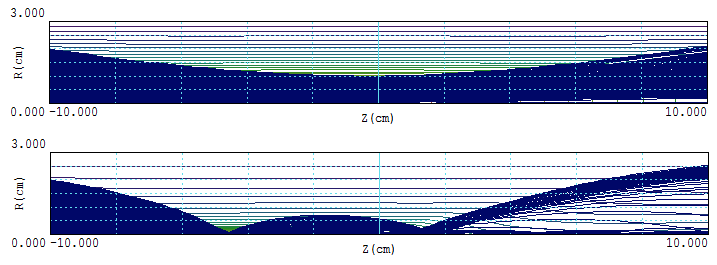Neutralization of electron beams can occur in transport regions with no applied electric field. In this case, ions resulting from collisions with a residual background gas accumulate, cancelling the electric fields generated by the beam space charge. Following a recent customer inquiry, I investigated methods to represent the effect of neutralization on beam dynamics in the Trak and OmniTrak programs. While there is a simple technique to represent neutralization in the current version of Trak, I found it necessary to add a new feature to OmniTrak.
To begin, it is easy to represent the neutralization of non-relativistic beams (where the self-magnetic forces are negligible). It is simply a matter of disregarding the beam-generated electric fields by using the Track mode in both programs. With regard to beam dynamics, neutralization is important only for relativistic electrons where the beam-generated magnetic-field forces play a significant role. First, I'll discuss the 2D Trak program. In a transport solution, the only source of electric field is the beam space charge. The goal is to reduce the electric field force while leaving the beam-generated magnetic force unchanged. The technique is to modify the EStat solution by introducing a relative dielectric constant in the beam transport region with value εr ≫ 1. For a given space-charge density, the electric field is reduced by a factor 1/εr with no effect on the beam magnetic field calculation. Figure 1 shows the effect on the standard ConvergingBeam example. Figure 1a shows a solution with εr = 1 and Fig. 1b has εr = 50. The maximum beam-generated potential drops from 147 kV to 9 kV. The only subtle point is to add a statement of the type
VACUUM(E) = 1
to the Particles section of the Trak input script. The command over-rides the default assignment of Material properties to regions with εr ≠ 1 or μr ≠ 1. In Fig. 1b, the self-magnetic field results in a beam pinch close to the entrance point. It is important to recognize that the solution downstream from this point may be inaccurate because the mesh resolution is probably insufficient for the calculation of beam fields at the tight neck.

Figure 1. Trak results for the ConvergingBeam example. a) Uneutralized beam b) Neutralized beam.

Figure 2. Equations for relativistic, paraxial electron motion.
Because OmniTrack does not make an independent calculation of the beam magnetic field in the SCharge mode, it was necessary to modify the program. Figure 2 (taken from the OmniTrak manual) shows the basis of the RelApprox option in the SCharge mode. The equations hold for a paraxial, relativistic electron beam in a region with no applied electric field. In the case of an uneutralized beam, the electric force is multiplied by a factor 1/γ^2 during orbit tracking to represent the sum of electric and magnetic forces. The equations suggest an approach to neutralized beam transport. The magnetic force equals the virtual electric force multipled by -β^2. When the new command NeutApprox appears in the Particles section for the SCharge mode, OmniTrak calculates the electric field in the standard way, but applies the force (-β^2) E to determine the particle dynamics. Figure 3 shows the results for the standard OmniTrak example CircExpand. Figures 3a and 3b show particle orbits and electrostatic potential for the RelBeam mode and for the RelApprox option in the SCharge mode. Figure 3c shows particle orbits and the virtual beam electric field (proportional to the beam-generated magnetic field) for the NeutApprox option in the SCharge mode. As with the Trak results, trajectories downstream of the tight pinch are not accurate. The output electric field file gives no information about the beam-generated electric field (theoretically zero), but can be used to map the beam magnetic field. For quantitative values, multiply E in V/m by -β/c to obtain B in tesla.

Figure 3. OmniTrak results for the CircExpand example. a) RelBeam mode. b) SCharge mode with RelApprox option. b) SCharge mode with NeutApprox option.
LINKS